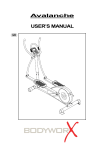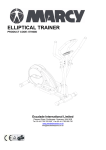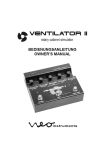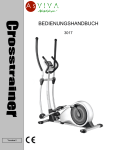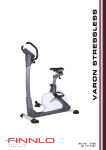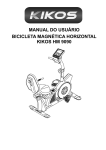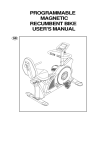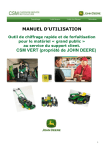Download MAGNETIC RECUMBENT BIK E USER'S MANUAL
Transcript
MAGNETIC RECUMBENT BIK E USER’S MANUAL GB This quality product is designed, manufactured, tested and certified for enhanced Fitness Training. Dear Customer, We want to thank you for having chosen a RECUMBENT BIKE product and wish you a lot of fun and success during training. Please note and follow the enclosed safety and assembly instructions carefully. If you have questions please do not hesitate to contact us. Table of Content: 1. 2. 3. 4. 5. 6. 7. Safety Instructions .............................. Assembly Instructions ........................ Computer Instructions.......................... Training Instructions ............................ Exploded Drawing ............................... Parts List ............................................. Training pulse rate .............................. P. 2 P. 3 P. 6 P. 9 P. 10 P. 11 P. 13 Safety Instructions GB Before you start training on your home RECUMBENT BIKE, please read the instructions carefully. Be sure to keep the instructions for information, in case of repair and for spare part delivery. The HM-9090 is made for home use only and tested up to a max.body weight of 100 kgs. Follow the steps of the assembly instructions carefully. Use only original parts as delivered. For assembly use only suitable tools and asks for assistance with assembly if necessary. Place the bike on an even, non-slippery surface. Because of possible corrosion, the usage of the home exercise bikes in moist areas is not recommended. Check before the first training and every 1-2 month that all connecting elements are tight fitting and are in the correct condition. Replace defective components immediately and/or keep the equipment out of use until repair. For repairs, use only original spare parts. In case of repair please ask your dealer for advice Avoid the use of aggressive detergents when cleaning the home exerciser. -2- Ensure that training starts only after correct assembly and inspection of the item. For all adjustable parts be aware of the maximum positions to which they can be adjusted/tightened to. The home exerciser is designed for adults. Please ensure that children use it only under the supervision of an adult. Ensure that those present are aware of possible hazards, e.g. movable parts during training. Consult your physician before starting with any exercise programme. He can advise on the kind of training and which impact is suitable. Warning: incorrect/excessive training can cause health injuries. Please follow the advice for correct training as detailed in training instructions. The load/work level can be adjusted by turning the tension control knob on the handle bar stem. Assembly Instruction Step 1 GB GB 1. Fasten front stabilizer (2) and rear stabilizers (3) each with 2 carriage bolts (45) from the underside of stabilizers. Secure with 2x- washers (46) to main frame (1). Step 2 Step 3 GB 1. Plug the computer cable (upper) (15) with cable at back of computer (14). Slide computer (14) and fix it onto the bracket at top of handlebar post (4) by 4 bolts (85). 2. Release knob (25) from fastener at back of handlebar post (4). Open up the fastener and attach handlebar (13) into fastener of handlebar post (4). Select the desired position for handlebar (13), fasten the knob (25) with washer (72) securely. 3. Plug hand pulse sensor wire (19) to jack at back of computer (14). GB 1. Connect the upper computer cable (15) with lower computer cable (16) securely. 2. Unscrew the pre-assembled 3 hex. Bolts (47) & washers (48). Put the handlebar post (4) into the main frame (1) and fix it with 3 hex.bolts (47) and washers (48). 3. Attach the tension control (17) onto right side of handlebar post (4). Secure with bolt (73) & washer (74) to the left of handlebar post (4). Step 4 GB 1. Attach seat post (7), to the seat bracket (10). Secure with 4 bolts (49) tightly. -3- Step 5 GB Step 7 GB 1. Unscrew 4 preassembled bolts (84) & washers (46) from back of seat (20). Attach the seat (20) to the seat post (7), secure 4 bolts (84) with washers (46) from underside to seat. 1. Screw pedal (44) onto the crossbar crank (9). The pedals are marked with R and L at the screw. Tighten the left pedal counter-clockwise, the right pedal clockwise. Step 6 Step 8 GB 1. Attach backrest (21) to seat post (7). Fasten the backrest (21) firmly with knob (26) & washer (48) from the back side of the seat post (7). 1. Connect right handlebar post (8) with seat bracket (10) by 2 bolts (50) tightly. 2. Proced the same to the left handlebar (8). -4- GB Step 9 GB 1. Now, your machine is ready for use. -5- Computer Instructions GB -6- -7- -8- Training Instructions To achieve a considerable improvement of your physical resistance and your health, some aspects of how to find the most efficient amount of training should be followed: If you have not been physically active for a longer period of time and also to avoid health risks you should consult your general physician before starting to exercise. Intensity To achieve maximum results the right intensity has to be chosen. The heart rate is used as guideline. As a rule of thumb the following formula is commonly used: With increasing improvement of fitness the training intensity should be increased to 70% - 85% of your maximum pulse rate. This can be done by increasing the resistance, a higher frequency or longer training periods. Training Organization Warm-up: Before every your training you should warm-up for 5-10 minutes. Here you can do some stretching and training with low resistance. Training session: Maximum pulse rate = 220 - Age While exercising the pulse rate should always be between 60% - 85% of the maximum pulse rate. For your personal training rates please see the attached pulse rate chart on page 13. When starting to exercise you should keep your rate at 60% of your maximum pulse rate in the first couple of weeks. With increasing improvement of fitness the pulse rate should be slowly increased to 85% of your maximum pulse rate. Fat burning The body starts to burn fat at approx. 60% of the maximum pulse rate. To reach an optimum at burning rate, it is advisable to keep the pulse rate between 60% – 70% of the maximum pulse rate. The optimum training amount consists of three workouts per week 30 minutes each. Example: You are 52 years of age and would like to start exercising. Maximum pulse rate = 220 - 52(age) = 168 pulse/min Minimum pulse rate = 168 x 0.6 = 101 pulse/min Highest pulse rate = 168 x 0.7 = 117 pulse/min During the first weeks it is advisable to start with a pulse rate of 101, afterwards increase it to 117. During the actual training a rate of 70% -85% of the maximum pulse rate should be chosen. The time-length of your training session can be calculated with the following rule of thumb: • • • daily training session: approx. 10 min. per unit 2-3 x per week: approx. 30 min. per unit 1-2 x per week: approx. 60 min. per unit Cool down: To introduce an effective cool-down of the muscles and the metabolism the intensity should be drastically decreased during the last 5 – 10 minutes. Stretching is also helpful for the prevention of muscle aches. Success Even after a short period of regular exercises you will notice that you constantly have to increase the resistance to reach your optimum pulse rate. The units will be continuously easier and you will feel a lot fitter during your normal day. For this achievement you should motivate yourself to exercise regularly. Choose fixed hours for your training session and do not start training too aggressively. An old quote amongst sportsmen says: “The most difficult thing about training is to start it.” Wish you have a lot of fun and success with your bike, -9- Exploded drawing GB - 10 - Parts List NO. GB Description Quantity 1 Main frame 1 2 Front stabilizer 1 3 Rear stabilizer 1 4 Handlebar post 1 5 Bolt (for backrest) 1 6 Seat rail 1 7 Seat post 1 8 Handle bar (L & R) 1 9 Cross bar 2 10 Seat adjustable plate 1 11 Pin (for seat adjustment bar) 1 12 Sleeve (for seat adjustment bar) 1 13 Handle bar 1 14 Computer 1 15 Computer cable (upper) 1 16 Computer cable (lower) 1 17 Tension control 1 18 Hand pulse sensor 2 19 Hand pulse sensor wire 1 20 Seat 1 21 Backrest 1 22 Front stabilizer cap (pair) 1 23 Sleeve 4 24 Rear stabilizer cap(pair) 1 25 Round knob (for handle bar #13) 1 26 Round knob (for backrest) 1 27 Cap (for plastic cover #32)(pair) 1 28 Cap (for seat rail) 1 29 Chaincover (L & R) 1 30 Disk 2 31 Decorator 2 32 Plastic cover (L & R) 1 33 Seat adjustment bar 1 34 Cap (for chaincover) 1 35 Stopper 1 36 Wheel (for seat adjustable plate) 4 37 Sensor fixture 1 38 Cap (for foam girp) 4 39 Foam grip (for handle bar #8) 2 40 Foam grip (for handle bar #13) 2 41 Foam (for seat rail) 4 42 Belt wheel 1 43 Plastic sleeve 1 44 Pedal (L & R) 1 45 Carriage bolt (for stabilizer & seat rail) 8 46 Washer (for stabilizer, seat rail,seat & wheel #36) 22 - 11 - 47 Bolt (for seat rail & handlebar post) 5 48 Washer (for backrest, handle bar post & pulley) 6 49 Bolt (for seat post) 4 50 Bolt (for handle bar #8, seat rail) 8 51 Bolt (for wheel #36) 4 52 Bolt (for stopper) 2 53 C – ring 1 54 Locknut (for wheel #36, seat rail) 6 55 Nut (for belt adjustor) 2 56 Belt adjustor (set) 2 57 Washer (for belt adjustor) 2 58 Washer (for belt wheel) 1 59 Washer (for flywheel) 2 60 End cap (for middle post) 1 61 End cap (for front post) 1 62 Screw (for crossbar) 8 63 Washer (for belt wheel) 2 64 Washer (for belt wheel) 1 65 Bearing (for belt wheel) 2 66 Washer (for belt wheel) 1 67 Nut (for crossbar) 2 68 Sleeve (for seat rail) 4 69 Screw (for chaincover & plastic cover #32) 11 70 Screw (for chaincover & plastic cover #32) 6 71 Screw (for sensor fixture) 1 72 Sleeve (for handle bar #13) 1 73 Bolt (for tension control) 1 74 Washer for tension control 1 75 Screw (for handle pulse sensor) 2 76 Magnet 1 77 Flywheel 1 78 Square cap (for seat post) 2 79 Bushing (for seat adjustment bar) 2 80 Protector 2 81 Allen key wrench 1 82 Screwdriver 1 83 Bolt (for pin#11) 2 84 Bolt (for seat) 4 85 Bolt (for computer) 4 86 Belt 1 87 Ring (for seat rail) 1 88 Plastic sleeve 1 - 12 - GB Training Pulse Rate The owner’s manual is only for the customer reference. - 13 -














